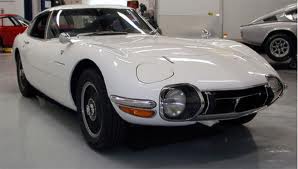


This edition of the Jaguar Mark VII M 3.4L is the 4 speed / Manual version and was first brought out in 1955. This was at around the same time as the introduction of the 1955 Ferrari 410 Superamerica Series 1 and the 1955 Mercedes SL Class 300SL Gullwing W198.This particular Jaguar Mark VII has a 3442cc Naturally Aspirated Petrol powerplant with 6 cylinders in a St formation.
The Mark VII shares its Petrol St6 engine configuration with the likes of the 1965 Aston-Martin DB6 1965 and the . If you're looking for other fast cars which share the Mark VII's Rear Wheel Drive, Saloon combination then how about the 1982 Fiat X1/9 1.5 8V or the 1965 Aston-Martin DB6 1965.
Weighing in at 1769 kgs (3899 lbs) this makes the Jaguar Mark VII M 3.4L in the same weight category as the 2023 Lamborghini Revuelto 6.5 V12 Petrol Hybrid or the give or take 50kg.
![Abarth 695 70th Anniversario 1.4 Turbo - [2020] image Abarth 695 70th Anniversario 1.4 Turbo - [2020] image](/editionimages/2071.jpg)
The Jaguar Mark VII shares the same bhp with the 2020 Abarth 695 70th Anniversario 1.4 Turbo (177 bhp)
In terms of power the 3442cc 12V St6 engine produces 190 bhp (141 kW) @ 5500 rpm similar to the 2020 Abarth 695 70th Anniversario 1.4 Turbo (177 bhp) or the 2020 Audi A1 Sportback 40 TFSI S tronic S line (197 bhp).
The Naturally Aspirated St6 throws out 203 lb-ft (275.2 Nm) @ 3000 rpm placing it with cars of similar torque performance figures such as the 2020 Abarth 695 70th Anniversario 1.4 Turbo (184 lb-ft) or the 2020 Audi A1 A1 Sportback 35 TFSI S tronic S line (184 lb-ft).
If one combines the weight with power or torque performance for the Jaguar Mark VII you can get a better idea of it's real world performance.
![Volkswagen-VW Golf 2.3 V5 - [2001] image Volkswagen-VW Golf 2.3 V5 - [2001] image](/editionimages/587.jpg)
The 2001 Volkswagen-VW Golf 2.3 V5 (132.3 bhp per ton) has similar Bhp Per Ton stats as the Jaguar Mark VII.
The Jaguar Mark VII has a Power to weight ratio of 107.4 bhp per ton and 114.7 lb-ft per ton. Bhp Per Ton figures of the 1955 Mark VII competing with the 2001 Volkswagen-VW Golf 2.3 V5 (132.3 bhp per ton) or the 1989 Toyota Celica GT Four ST185 (132.2 bhp per ton).
If you agree with the late great Carroll Shelby then arguably an even better indicator of potential performance, Torque. Use weight as well and you end up with - Torque per ton, with the Jaguar Mark VII generating around 114.7 lb-ft per ton. If you're curious as to what other cars have as much torque to weight then look no further than the 1977 Triumph Stag 3.0 V8 Convertible Mk2 (139.5 lb-ft per ton) or the 1963 Ford Cortina MkI Lotus Type 28 (139.3 lb-ft per ton).
With a 0-60mph time of 14.10 secs or a 0-100km/h (0-62mph) of 14.6 secs, this made the Jaguar Mark VII M 3.4L as fast as the 1976 Ford Cortina Mk4 1600 GL (14.30 secs) the 1967 Vauxhall-Opel Viva Brabham 1.2 8v (14.40 secs) the 1951 Mercedes 300 S Roadster (14.50 secs) the or the 1979 Jeep CJ-5 Renegade 4.2L (15.00 secs). This Jaguar Mark VII M 3.4L is also faster than the 1976 Ford Cortina Mk4 1600 GL (14.30 secs) the 1967 Vauxhall-Opel Viva Brabham 1.2 8v (14.40 secs) the 1951 Mercedes 300 S Roadster (14.50 secs) the and the 1979 Jeep CJ-5 Renegade 4.2L (15.00 secs).
When talking about the performance of the Jaguar Mark VII on the drag strip it can reach a quarter mile in an estimated 17.15 secs @ 79.8 mph. Similar performance down the quarter mile can be found with the the 2006 Alfa-Romeo Brera 3.2 V6 Qtronic (17.08 secs), the 2008 Volkswagen-VW Scirocco 2.0 TSI GT (17.09 secs), and the 2002 Vauxhall-Opel Calibra 2.0i 16v Turbo (17.10 secs).
Modern performance cars are often artificially restricted to 155mph. The 1955 version of the Jaguar Mark VII M 3.4L has a maximum speed of 104mph.
If maxing out your car on the AutoBahn is your thing and you're wondering what's faster than the 1955 Jaguar Mark VII M 3.4L then how about the 2011 Morgan 3 Wheeler 2.0l V-Twin (115 mph), the 2007 Ford Taurus AWD 3.5 V6 (115 mph), or the 1999 Ford Fiesta 1.6 Zetec S (115 mph).










Ford Torino 2nd Gen Cobra SportsRoof Boss
Engine: Naturally Aspirated Petrol | 7033cc 16v V8
Top Speed: 114 mph
0-60mph: 5.70 seconds

Porsche 356 B 1600S Super
Engine: Naturally Aspirated Petrol | 1582cc 8v F6
Top Speed: 162.5 kph
0-100kph: 13.9 seconds



















